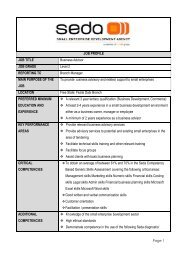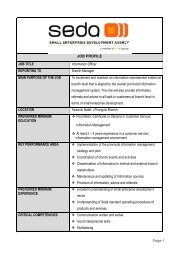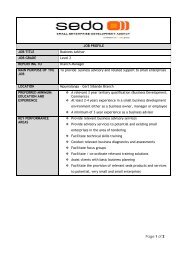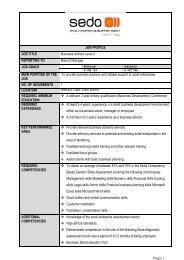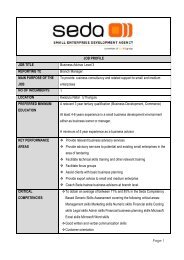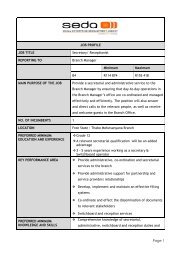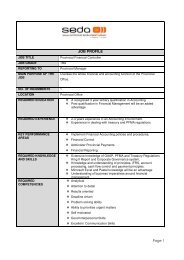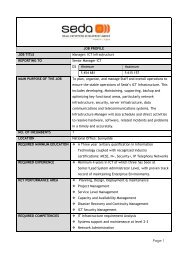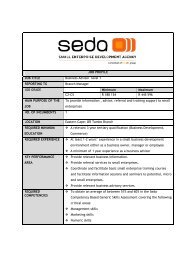Assessment of Cooperatives in the Poultry Industry - 2013.pdf - Seda
Assessment of Cooperatives in the Poultry Industry - 2013.pdf - Seda
Assessment of Cooperatives in the Poultry Industry - 2013.pdf - Seda
Create successful ePaper yourself
Turn your PDF publications into a flip-book with our unique Google optimized e-Paper software.
Research Report: Address<strong>in</strong>g <strong>the</strong> Needs, Opportunities and Challenges <strong>of</strong> <strong>Cooperatives</strong><br />
and Collectively Owned Enterprises <strong>in</strong> <strong>the</strong> <strong>Poultry</strong> and Related Industries<br />
The majority (85%) <strong>of</strong> cooperatives who kept f<strong>in</strong>ancial records did this through bookkeep<strong>in</strong>g. Only<br />
one cooperative surveyed used a computer spread sheet to track <strong>the</strong>ir spend<strong>in</strong>g and earn<strong>in</strong>gs. If<br />
more cooperatives had made use <strong>of</strong> spread sheets it would have been a positive <strong>in</strong>dicator that<br />
cooperatives are able to use computer skills to assist <strong>the</strong>ir budget<strong>in</strong>g and to track <strong>the</strong>ir spend<strong>in</strong>g.<br />
Ano<strong>the</strong>r more sophisticated method was <strong>the</strong> appo<strong>in</strong>tment <strong>of</strong> an auditor to assist with <strong>the</strong> exist<strong>in</strong>g<br />
bookkeep<strong>in</strong>g. The appo<strong>in</strong>tment <strong>of</strong> a f<strong>in</strong>ancial advisor is, however, a costly exercise and is not viable<br />
for many small cooperatives. O<strong>the</strong>r methods used <strong>in</strong>cluded <strong>the</strong> use <strong>of</strong> receipts or <strong>the</strong> use <strong>of</strong> books<br />
alongside receipts.<br />
Due to <strong>the</strong> lack <strong>of</strong> accurate and up to date record keep<strong>in</strong>g it is difficult to ga<strong>in</strong> <strong>in</strong>formation from<br />
cooperatives about <strong>the</strong> bus<strong>in</strong>ess turnover, <strong>in</strong>come, expenses and pr<strong>of</strong>it overall. Due to this<br />
constra<strong>in</strong>t, cooperatives were <strong>in</strong>stead asked how pr<strong>of</strong>its are dealt with <strong>in</strong> <strong>the</strong> bus<strong>in</strong>ess.<br />
The figure below (Figure 4-10) illustrates how cooperatives deal with pr<strong>of</strong>its. Approximately 41% <strong>of</strong><br />
respondents stated that pr<strong>of</strong>its are distributed amongst <strong>the</strong> members <strong>of</strong> <strong>the</strong> cooperative, with 28%<br />
re<strong>in</strong>vest<strong>in</strong>g <strong>the</strong>ir pr<strong>of</strong>its back <strong>in</strong>to <strong>the</strong> bus<strong>in</strong>ess. Some 14% <strong>of</strong> cooperatives <strong>in</strong>dicated that <strong>the</strong>y were<br />
not mak<strong>in</strong>g any pr<strong>of</strong>its.<br />
The way <strong>in</strong> which cooperatives deal with pr<strong>of</strong>its <strong>in</strong>dicates a great deal about where <strong>the</strong>y are plac<strong>in</strong>g<br />
priority with<strong>in</strong> <strong>the</strong> bus<strong>in</strong>ess. The high number <strong>of</strong> cooperatives who distribute pr<strong>of</strong>its amongst<br />
members <strong>in</strong>dicates a lack <strong>of</strong> long-term plann<strong>in</strong>g with<strong>in</strong> <strong>the</strong> bus<strong>in</strong>ess. It is likely that certa<strong>in</strong><br />
cooperative members are fac<strong>in</strong>g harsh f<strong>in</strong>ancial times and thus need <strong>the</strong> pr<strong>of</strong>it <strong>in</strong> order to support<br />
<strong>the</strong>mselves and <strong>the</strong>ir families. However, if money is not re<strong>in</strong>vested <strong>in</strong>to <strong>the</strong> bus<strong>in</strong>ess, <strong>the</strong>re is little<br />
scope for growth. Positively, 45% <strong>of</strong> respondents ei<strong>the</strong>r re<strong>in</strong>vest <strong>the</strong> pr<strong>of</strong>its or put <strong>the</strong> money <strong>in</strong>to<br />
<strong>the</strong> bank. This means that almost half <strong>of</strong> <strong>the</strong> cooperatives surveyed are creat<strong>in</strong>g an <strong>in</strong>vestment <strong>in</strong> <strong>the</strong><br />
long- term success <strong>of</strong> <strong>the</strong>ir bus<strong>in</strong>ess.<br />
Figure 4-10: Application <strong>of</strong> Pr<strong>of</strong>its <strong>in</strong> <strong>Cooperatives</strong><br />
14%<br />
17%<br />
41%<br />
Distribute<br />
Re-<strong>in</strong>vest<br />
Save/ Bank<br />
No pr<strong>of</strong>it<br />
28%<br />
50 | P a g e U r b a n - E c o n : D e v e l o p m e n t E c o n o m i s t s<br />
Source: Urban-Econ Survey, 2013



